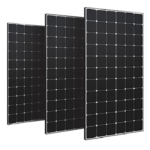Solar Electricity Terms
Looking into solar electricity?
You may have some questions?
Are you starting to read into solar and seeing more terms then you know what they are?
Here are some everyday solar terms that will help in your research.
 Array – Also a “Solar Array” is when multiple solar panels are strung together to form an array. The more panels you wire together the more power you will capture from the sun to power you home or business.
Array – Also a “Solar Array” is when multiple solar panels are strung together to form an array. The more panels you wire together the more power you will capture from the sun to power you home or business.
AC / DC – Alternating Current & Direct Current – the types of electricity used to power your home, before and after the solar microinverters if you have solar installed.
Kilowatt – abbreviated (kW), a measure of 1,000 watts of electrical power. . . so a saw needs 1,000 watts to run it needs 1kW to work. Solar panels are defined by the watts they produce, they higher watt panel, the more power it produces.
Kilowatt-hours – abbreviated (kWh), a measure of electricity equivalent to a power consumption of 1,000 watts for 1 hour.
Microinverter – a solar micro-inverter is a plug and play device used in solar electricity that converts direct current to alternating current. The idea of microinverters is that they isolate the panel so weather, shade, snow do not effect the whole array, rather just one panel.
PV – Photovoltaics is the conversion of light into electricity using semiconducting materials. Electrons in these materials are freed by solar energy and can be induced to travel through an electrical circuit creating power. That power can be used in your home or business.
Solar Azimuth – This has to do with the position of the sun relative to the positioning of the solar panels. The azimuth refers to the compass angle of the sun as it moves throughout the day.
Solar Zenith – this refers to the angle of the sun looking up from the ground. These angles are important when determining the correct angles your solar panels should be placed for optimal solar generation. Be sure to have a solar analyst create an array that works for your home or business. Request a FREE Solar Quote Today!
 True-Up Bill – Any remaining credits or kilowatt-hours (kWh) you return to the grid exceeds the amount of kWh’s you have purchased, you will be compensated for the difference. The amount you are compensated is usually less then what you pay for the energy from the utility but be sure to check with your utility for specifics.
True-Up Bill – Any remaining credits or kilowatt-hours (kWh) you return to the grid exceeds the amount of kWh’s you have purchased, you will be compensated for the difference. The amount you are compensated is usually less then what you pay for the energy from the utility but be sure to check with your utility for specifics.
Shading – When talking about solar energy, shading refers to the lack of sunlight reaching the solar panels, not creating solar energy. Caused by trees, canopies, snow, other buildings, etc. A solar array needs to be placed strategically so the shading does not impede solar production.
Solar Monitoring App. – This is a system that can help monitor you solar system production to help ensure your system produces the electricity you need for you home or business. Ask for a FREE Solar Quote Today and experience solar monitoring for yourself.
A Solar Analyst can help answer any questions you may have and provide you with a custom solar quote for your home or business.
Give us a call today 619-743-9193.
References:
https://us.sunpower.com/solar-array-definition
https://www.seia.org/initiatives/photovoltaics

